Just south of the Galapagos’ Marchena Island, there’s a dive spot known by locals as the “fish arena.”
There, within the choppy, cool waters of the Pacific, thousands of colorful fish swim in schools, lobsters poke their long antennae out of rocky outcrops, dolphins bear their young and moray eels gape menacingly at visitors who swim too close.
Charles Darwin documented the rich biota of these islands in the early 1800s. In more recent times, an unofficial network of local tour boats and fishing vessels has worked to protect it, by keeping an eye out for those who might harm the marine bounty. But the pandemic has grounded this surveillance fleet, creating an opening for outsiders.
Earlier this summer, more than 300 Chinese fishing vessels — many designed to hold 1,000 tons of catch — waited at the marine preserve’s border, ready to snatch up sea life as it migrated south toward the waters off Peru and Chile.
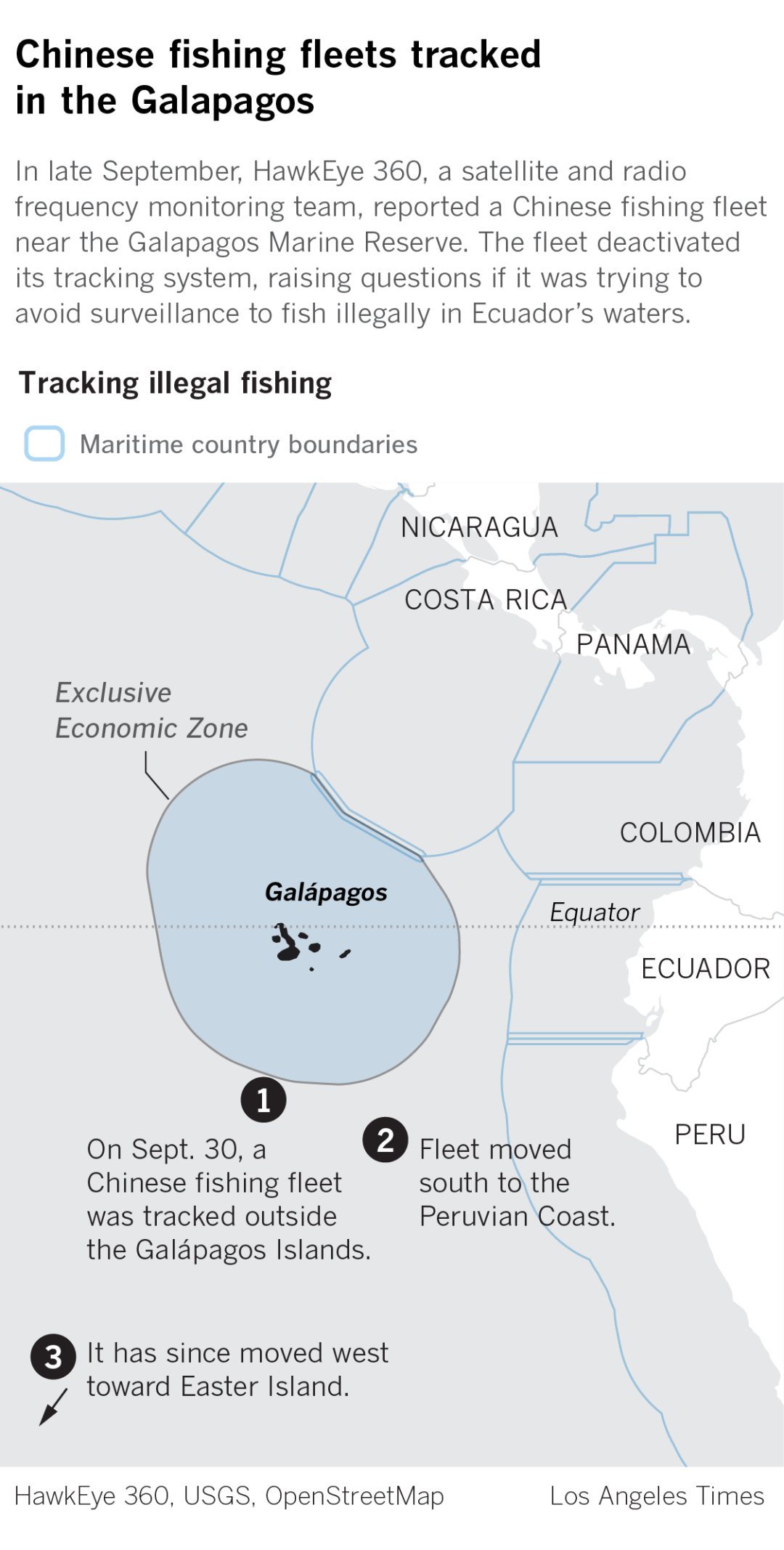
By some estimates, China has a “distant water” fishing fleet of 17,000 vessels that has been involved in fishing conflicts off the coasts of West Africa, Argentina and Japan in recent years. Now this fleet is triggering similar anger off Ecuador and Peru, two nations highly dependent on their robust near-shore fisheries.
“This is an attack on our resources,” said Ángel Yánez Vinueza, the mayor of Santa Cruz canton, the Galapagos’ equivalent of a province. “They are killing the species we have protected and polluting our biota with the plastic waste they drop overboard. They are raping the Galapagos.”
The fleet is hardly the only threat to this park, a UNESCO world heritage site.
As a result of the COVID-19 pandemic, tourism has plummeted — tour boats have been moored in Santa Cruz Island’s Academy Bay for months, while shops and restaurants are shuttered along Puerto Ayora’s main drag, Avenida Charles Darwin.
It has laid bare the vulnerability of an economic model that is 90% dependent upon tourism dollars, while also highlighting the extraordinary beauty and remoteness of the islands — and the magic that is lost when thousands of tourists descend daily into this fragile ecosystem.
The Galapagos marine reserve faces threats from industrial fishing, climate change and reduced funding for conservation.
During a recent visit to the Galapagos, a Times reporting team — the only visitors touring the park by boat — witnessed penguins swimming alongside tropical fish and sea turtles, krill blooms clouding the shallow waters with pink flotsam, and migrating tuna and hammerhead sharks meandering through the darker, deeper waters.
Normally, pods of dolphins and whales stay out of the busy harbor in Academy Bay. But with the tourist boats out of commission, they are swimming around the area for the first time in decades. Brown pelicans are nesting in the nearby cliffs and mangroves — a sight Fiddi Angermeyer, 68, a local tour operator and business owner, says he hasn’t seen since he was a kid.
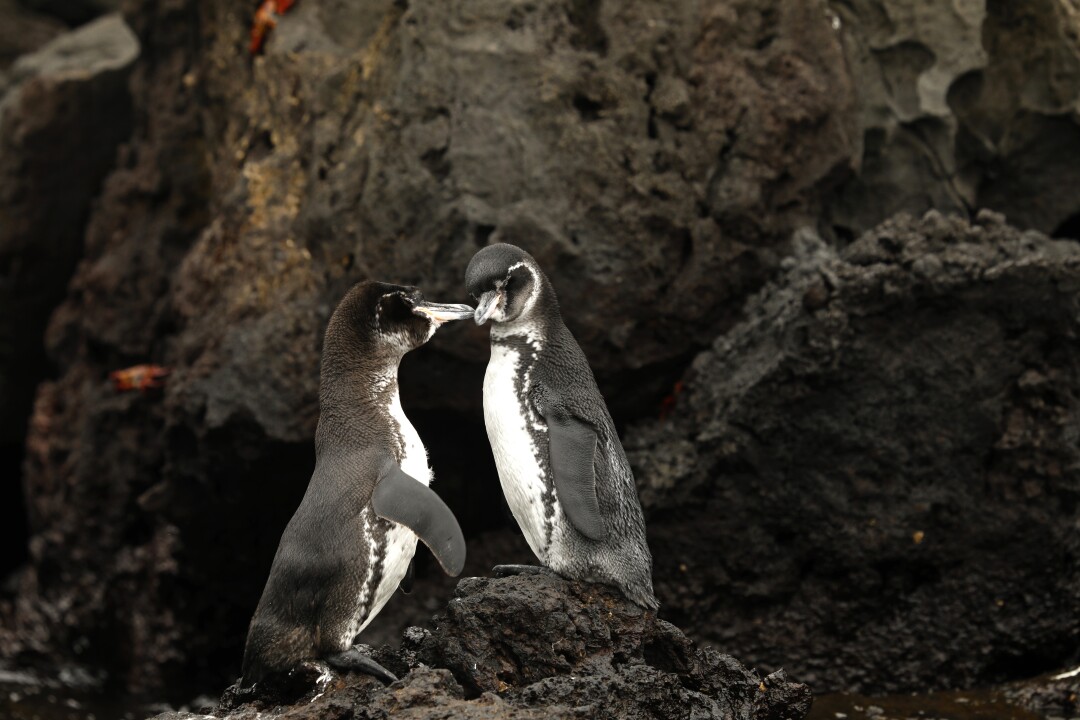
Animals like these Galapagos penguins have flourished as the pandemic keeps visitors away, but the lack of tourism could devastate the park’s funding and has left an opening for poachers to move in.
(Carolyn Cole / Los Angeles Times)
The situation has prompted politicians, environmentalists and business owners to wonder how the region can regrow and provide a vibrant economy and jobs for its residents while maintaining the wild essence of the park and tamping down on its carbon-intensive requirements — the jet planes and cruising boats of international tourism.
“It’s like it was 30 or 40 years ago,” said Mary Crowley, the director of Ocean Voyages Institute, a Sausalito, Calif., environmental organization working to rid the oceans of plastic. She’s been to the Galapagos 23 times since 1972. “That splendor has returned.”
It’s also exposed the critical role tourism plays in the upkeep and safety of the park: Without visitors traveling to the outer islands and local fishing crews patrolling the park’s waters, no one is watching for poaching or picking up the litter and plastic floating in from the mega-fleets and mainland.
The calculus is clear, said Angermeyer: “If there are no tourists, there is no park. And if there’s no park, there are no tourists.”
A world heritage site, the Galapagos marine reserve faces threats from industrial fishing, climate change and a drastic drop in tourism and funding for conservation.
Mosquera Island is not much more than a skinny spit of sand and rock off Baltra Island, where the Galapagos Islands’ main airport is located.
On a recent afternoon, baby sea lions, Galapagos pigeons and Sally Lightfoot crabs scrambled across the rocks or lolled in the sunbaked sand on Mosquera’s southern shore. The airport and the channel separating the islands were largely silent — just the sound of waves lapping and sea lion moms and pups barking back and forth.
But a walk around the rocky edge of the island showed something deeply distressing to Fernando Ortiz, a park guide and former director of the region’s chapter of Conservation International: Scores of plastic bottles, shoes and equipment packaging — labeled with Chinese characters — poked out of the jagged rocks.
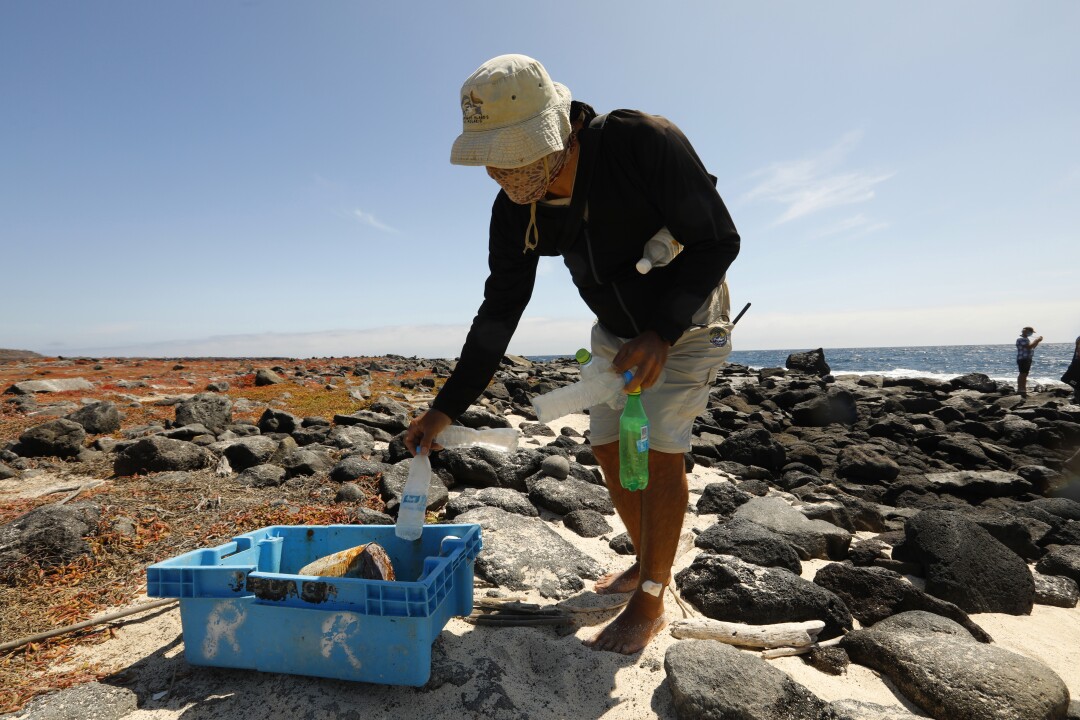
Fernando Ortiz, a park guide and former director of the region’s chapter of Conservation International, picks up bottles, shoes and equipment packaging from the jagged rocks of Mosquera Island in the Galapagos.
(Carolyn Cole / Los Angeles Times)
“These are from those boats,” said Ortiz, pointing south, toward the horizon, where the fleet of Chinese fishing vessels had congregated roughly 200 nautical miles away. He noted the “newness” of the items, with labels not faded by sun or sea.
In July, the Ecuadorian navy had become alarmed as the fleet approached the edge of the 200-mile zone around the park where commercial fishing is illegal.
For years, fishing crews have trawled this zone, hoping to capitalize on the fruits of conservation — increasingly healthy and robust fish stocks — said Boris Worm, a researcher at Dalhousie University in Canada who has studied the fishery.
But last summer, the number of vessels exploded. In late August, a U.S. Coast Guard cutter was called in to help Ecuador’s navy patrol the area.
Capt. Brian Anderson, commanding officer of the Coast Guard cutter Bertholf, said the Chinese brought in a tanker ship, which provided fuel to the other ships, and processing ships, where the fishing vessels could dump their harvest and go out and collect more.
“It was like a city,” he said, noting the fleet had all the pieces it needed to stay out for months without returning to home ports.
Several of the Chinese vessels weren’t reporting their location electronically, he said, and one was reporting its location as Alaska. But without jurisdiction in the area, and nothing blatantly illegal to report to the Ecuadorian navy, the Coast Guard was relegated to watching, he said.
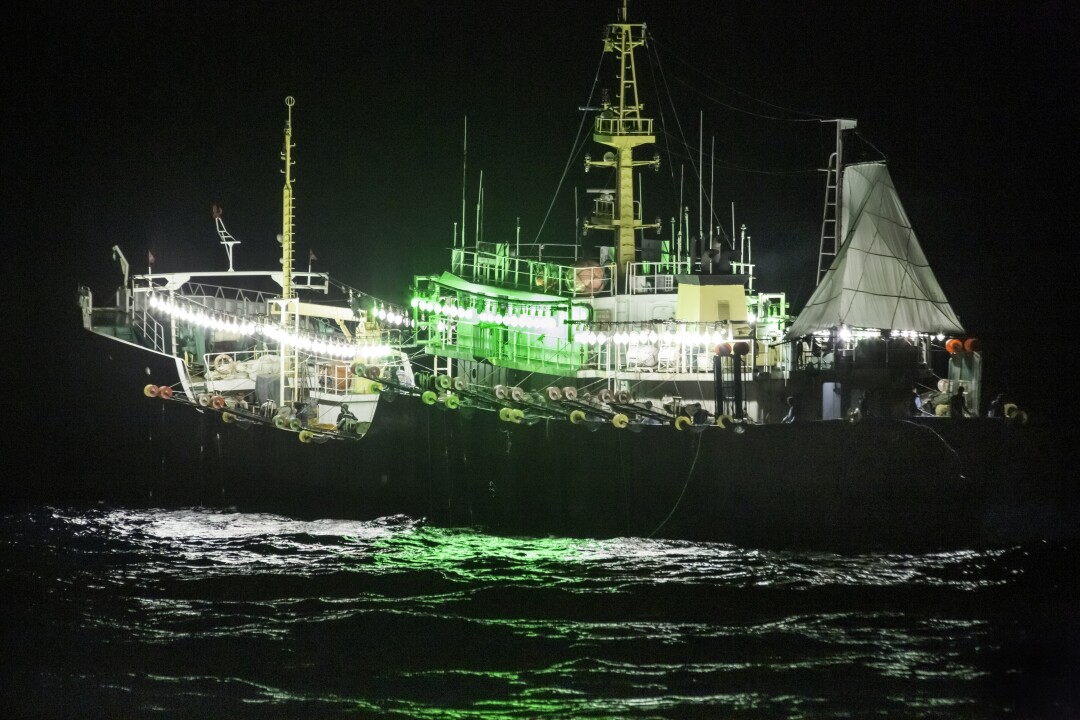
A Chinese fishing boat off the coast of Peru lights up the surrounding water to attract squid in 2018.
(Simon Ager Photography)
For its part, China has contended it has “zero tolerance” toward illegal fishing. In a July 23 statement, the Chinese Embassy in Quito said China respects Ecuador’s measures to protect the environment and preserve marine resources.
But John Serafini, chief executive of a Virginia-based military defense and commercial data analytics start-up called HawkEye 360, said his company’s research — which relies on radio frequency and satellite imagery to process movement — showed many suspicious signals coming from within the zone this summer.
In 2017, a Chinese fishing vessel intercepted off of the Galapagos was found to be hauling 300 tons of fish, which included tens of thousands of illegally caught sharks.
Mayor Vinueza said the continuing presence of the fleet is an assault on the preserve and his residents’ livelihood, especially in the face of the economic devastation the park is suffering.
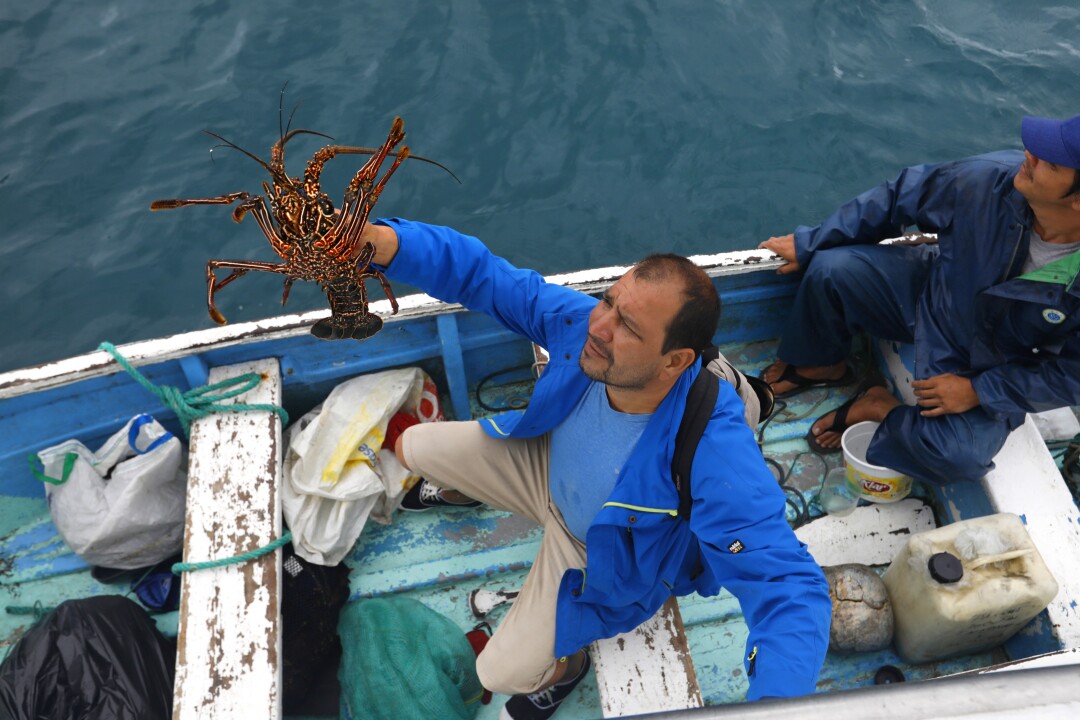
Local fishermen try to sell lobster to boaters in Santa Cruz Island’s Academy Bay. The pandemic has caused a desperate economic situation for the residents who depend on tourism in the Galapagos.
(Carolyn Cole / Los Angeles Times)
In August, hundreds of Santa Cruz canton residents took to the streets to protest the fishing fleet — worried it was depleting the park’s natural resources, potentially giving one more reason for tourists not to return.
On Sept. 24, a commercial flight from Guayaquil to Baltra Island had only nine passengers aboard. Though Avianca Airlines once had daily flights to the island, those have dropped to a sporadic two or three a week.
The lack of tourists has clearly hit the businesses that rely on them, as well as the fishermen and farmers who supply the industry.
Denato Rendon, a local fisherman, has been giving his fish away while his cooperative tries to find new buyers on the mainland and overseas. William and Noralma Cabrera, farmers in the hills outside Puerto Ayora, are also giving food away, and sometimes bartering — trading their tomatoes and cucumbers for goods such as fish, chicken or milk.
“We’re a close-knit community,” the father of two said as he stood in front of greenhouses where beans, lettuce and tomatoes were ripening.
The dearth of tourists has also hit the park, which relies on $100 entry fees from visitors. The fees provide money for preservation, conservation, upkeep and enforcement. More than 97% of the Galapagos is protected parkland; the rest is residential.
On Sept. 24, the park pulled in $1,240 from tourist fees at the islands’ two airports — just 4% of last year’s collection for the same day, said Norman Wray, president of the Government Council of Galapagos.
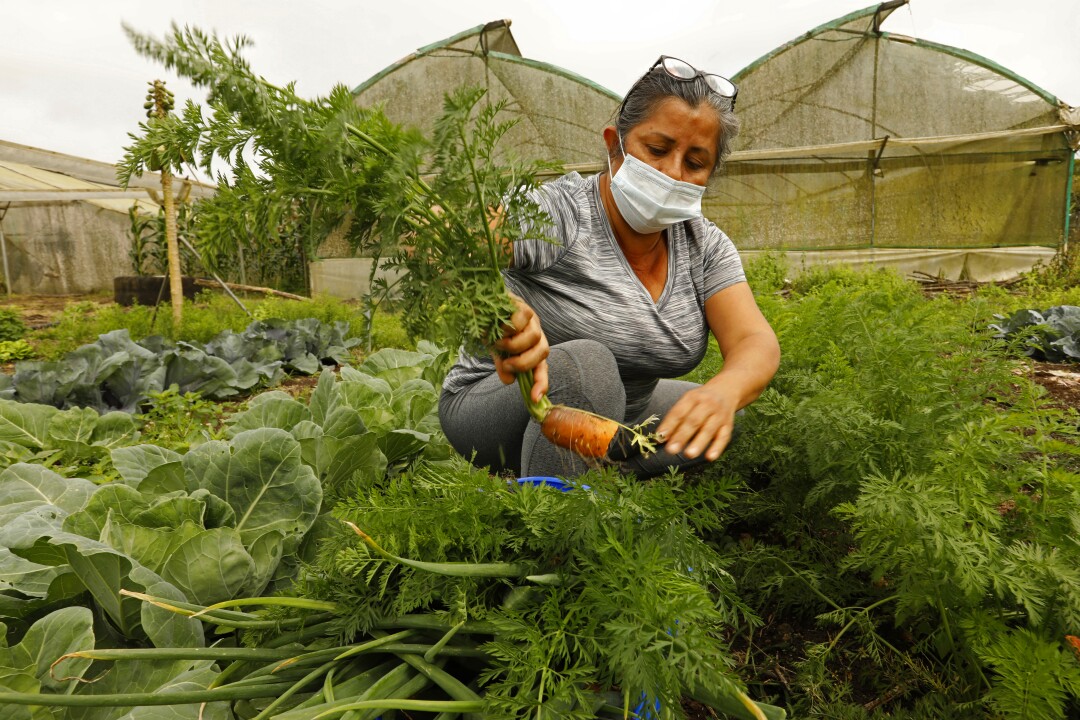
Noralma Cabrera and her husband, William, are farmers in the hills outside Puerto Ayora. Without tourism driving the economy, they’ve started giving food away.
(Carolyn Cole / Los Angeles Times)
“We can’t keep things going like this,” Wray said of the high unemployment and tourism exodus from the islands. To try to counteract that, Wray and others are underscoring the safety of the islands and the seriousness with which the industry takes the pandemic.
“Look around you,” Vinueza said, “it is safe here. We have strict protocols. We won’t let the virus in.”
Proof of a negative PCR coronavirus test, taken within 96 hours of arrival in the Galapagos, is required for entry. That’s more stringent than the requirement to get into Ecuador, which requires a PCR coronavirus test to be taken within 10 days of arrival.
Seemingly everyone in the now-quiet Puerto Ayora wears a mask, and all businesses require patrons to douse their hands and shoe soles in alcohol before entry. Boat crews are even spraying the hands of scuba divers just emerging from the ocean before they let them back on their boats.
“We just can’t be too careful,” said Ortiz, who works on Angermeyer’s ship, the Passion, as a guide. “And it’s important that people know how seriously we take this disease.”
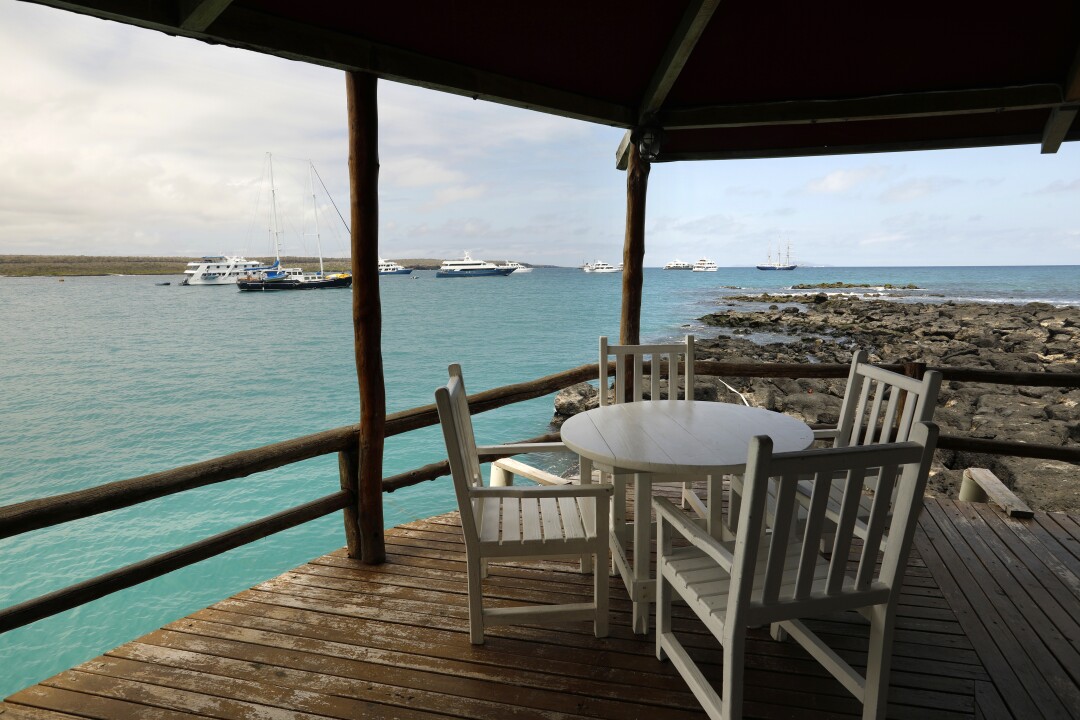
As a result of the pandemic, tourism has plummeted in the Galapagos and tour boats have been moored in Academy Bay for months, while shops and restaurants are shuttered.
(Carolyn Cole / Los Angeles Times)
Still, there’s the sense here that the pandemic may have changed the tourist economy in the islands forever — and in some respects, Wray said, that may be for the better.
He noted that broadband cables are being laid along the ocean floor, which soon will connect the islands with high-speed internet — making it possible for a high-tech academic center or industry, such as Google or Amazon, to relocate or establish satellite offices in the islands.
“What a laboratory to work in,” he said, describing the wildness, beauty and history of the islands. And such a prospect, he said, could help park managers imagine a future that didn’t require international tourists to board jumbo jets or gas-guzzling pleasure cruisers to meander around the islands.
For the park to survive and its wildlife to thrive, the future of tourism on the island and in the region must change, Wray said.
Though the pandemic and Chinese fishing fleet pose threats, he said, they also have offered a moment for the park’s leaders to consider more sustainable models for the Galapagos and the flora and fauna that tourists come to see.
“We can’t survive without them,” he said. “But we need to find a balance.”
"fish" - Google News
October 18, 2020 at 07:00PM
https://ift.tt/3kbwncP
Galapagos Islands threatened by fishing fleets and COVID-19 - Los Angeles Times
"fish" - Google News
https://ift.tt/35JkYuc
https://ift.tt/3feFffJ
Bagikan Berita Ini
















0 Response to "Galapagos Islands threatened by fishing fleets and COVID-19 - Los Angeles Times"
Post a Comment